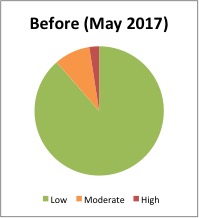In FY17, computer ergonomic (ergo) exposure was the second highest recordable injury, accounting for 22% of the Laboratory’s recordable injuries. To address this problem head on, the Engineering Division Ergo Advocate Team has implemented a proactive approach to reducing ergo risks in the division.
 Each week since June, the ergo duo, Eva Pan and Marshall Granados, review ergonomics reports to prioritize and target employees identified as high and moderate risk for ergonomic injury. Starting with the individuals at the highest risk level and with the highest number of ergo issues, they initially conduct drop-in visits for a casual ergo safety discussion and to offer recommendations to reduce ergo risk. Working as a team, they are able to discuss issues with the employee, make and document observations, and make workstation adjustments during the visit. If a drop-in visit proves to be ineffective or inconvenient, they calendar a formal meeting with the employee. Each employee is visited at least twice to offer recommendations and monitor progress towards implementation and improvement of fatigue or discomfort.
Each week since June, the ergo duo, Eva Pan and Marshall Granados, review ergonomics reports to prioritize and target employees identified as high and moderate risk for ergonomic injury. Starting with the individuals at the highest risk level and with the highest number of ergo issues, they initially conduct drop-in visits for a casual ergo safety discussion and to offer recommendations to reduce ergo risk. Working as a team, they are able to discuss issues with the employee, make and document observations, and make workstation adjustments during the visit. If a drop-in visit proves to be ineffective or inconvenient, they calendar a formal meeting with the employee. Each employee is visited at least twice to offer recommendations and monitor progress towards implementation and improvement of fatigue or discomfort.
Since the implementation of this new approach to ergo risk management, high risk ergo instances have been eliminated and moderate instances have been reduced by 46%. Out of 245 employees, the percentage of low risk employees has increased from 89% to 95%. The team continues initiate contact and work with the remaining 5% of employees who remain at the moderate risk level, some of which have chronic ergo issues that are being actively managed.
Not only have the numbers improved, but actively managing ergo risks has also had a positive effect on employee morale. Employees have expressed appreciation that their well-being is being considered. One employee stated, “I’m not used to people caring about me, only my output and the work that I do.”
While doing an assessment, the ergo duo discovered that the ergo risk they were assessing for one employee actually impacted the entire control room used by several employees in multiple divisions. Six workstations used the same obsolete, unadjustable chairs that required users to hunch to perform their work. In some cases, the employees spent more time at these workstations than they spent at their desks. In result of actions prompted by the initial ergo assessment of one employee, all six workstations are scheduled to be upgraded to current ergo standards, eliminating the ergo hazard for the group.
Though this project began as a way to reduce the ergo risk in the division, the benefits have reached beyond what was anticipated. The team approach promotes continuous progress and the partner-accountability helps to maintain consistency. Additionally, safety and morale of employees has improved and spills over into adjacent workspaces. With this new proactive approach to managing ergo risks, we hope to eliminate preventable ergonomic injuries in the division.


